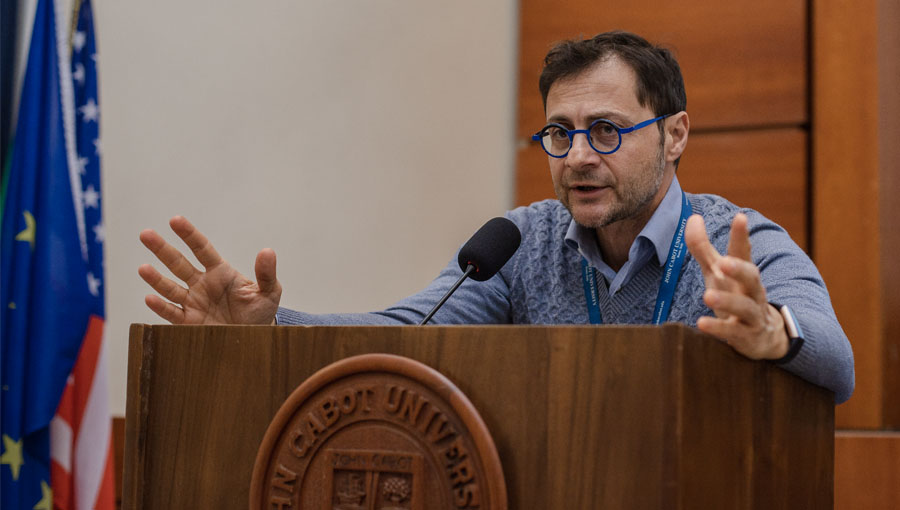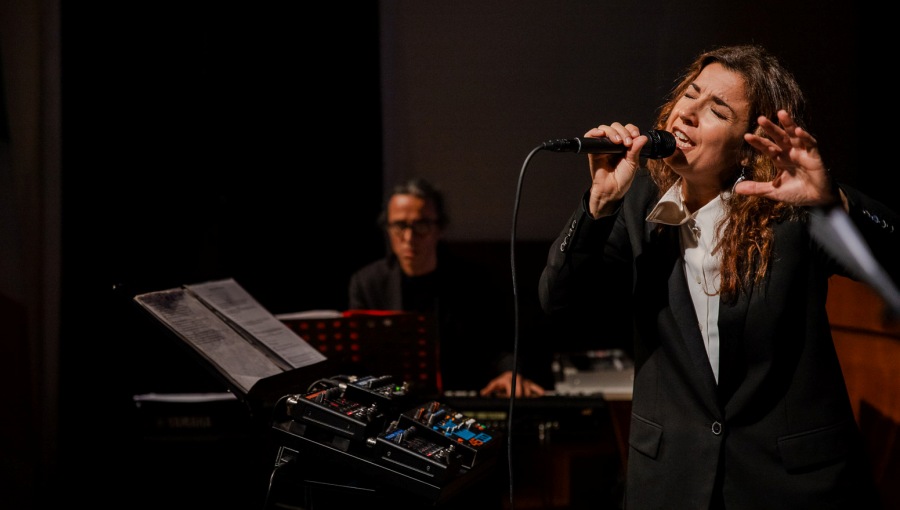Translating Song Lyrics: The Case of Italian Cantautori
On March 20, 2023, the Department of Modern Languages and Literature welcomed Francesco Ciabattoni for a lecture entitled “Translating Song Lyrics: The Case of Italian Cantautori.” Originally from Turin, Professor Ciabattoni earned a Ph.D. in Italian Studies from Johns Hopkins University. His research focus lies on Dante and the Middle Ages, the twentieth-century short story, and the interplay of music and literature.
Currently a professor of Italian Literature at Georgetown University, Ciabattoni is the founder of www.TheItalianSong.com, the first website to provide Italian song lyrics and their English translations, as well as commentaries on artists and songs. Ciabattoni illustrated the goals and strategies employed on the website, which has a primarily educational purpose and aims to spread Italian culture to a global audience by translating the most significant songs and contextualizing Italian singer-songwriters from the 1950s onward. Ciabattoni avails himself of the collaboration of professors, researchers, and journalists on both sides of the Atlantic.

Professor Francesco Ciabattoni
Moving from the critical frames provided by scholars Pierangela Diadori, Laura Salmon Kowarski, and JCU’s own Paolo Prato, Ciabattoni showed examples of how a song can be translated differently for different purposes. He began by giving a brief historical and cultural definition of what cantautori (singer-songwriters) and cantautrici (female singer-songwriters) are to the Italian cultural legacy and explained that the phenomenon refers to a distinctly Italian artistic and cultural experience. “The words cantautore and cantautrice indicate a kind of artistic prestige, a political or social commitment, and even a sort of prophetic aura that was specific to those artists.” Many of these singer-songwriters were oriented on the left side of the political spectrum, at least until the late 1970s, when more attention began to be paid to individual and private spheres, said Ciabattoni.
Ciabattoni explained that his website also includes singers who have never written a line, but whose personalities come through so strongly that they can be considered “co-authors” of their songs. He cited Mia Martini as a perfect example of a singer who was not a songwriter but whose voice and interpretation of songs were so iconic that hardly anyone else can sing them. He discussed the powerful 1971 song “Padre davvero,” a strong rebellion against patriarchy as seen through the generational conflict between a young woman and her father.
Ciabattoni then played “Il numero d’appello” (“The Roll Call Number”), a 1972 song written by Gianni Nebbiosi and sung by Maria Monti, one of Italy’s first cantautrici. An example of a socially aware song, the piece is about a mentally ill person forced to undergo shock treatments. This was the period before the Italian Mental Health Act of 1978 took effect, effectively closing all mental asylums and eventually replacing them with community-based services.

Professor Francesco Ciabattoni addressing students in the Aula Magna Regina
To illustrate the types of choices that translators must make, Ciabattoni played “Una storia sbagliata,” a 1980 song by cantautori Fabrizio De André and Massimo Bubola about the murder of Italian intellectual, author, and director Pier Paolo Pasolini. Instead of translating the title as “A Wrong Story,” Ciabattoni’s students came up with “A Messed Up Story,” since the literal translation would have been inaccurate. “A Messed Up Story” reflects the “mess” behind this tragic death whose circumstances are still unclear, and also evokes Quer pasticciaccio brutto de via Merulana (That Awful Mess on Via Merulana) by Carlo Emilio Gadda, where “pasticciaccio” is translated as “awful mess.”
Ciabattoni also gave examples of song translations that have been adapted to the original music, such as the album released in English in the U.S. and the U.K. by Lucio Battisti, one of Italy’s best-loved cantautori. The record’s commercial outcome was a disappointment, possibly because it was transplanted into a context where it didn’t seem to belong, but also because not much was done to promote it.
Ciabattoni then discussed the choices that were made by Fabrizio De André and Massimo Bubola when they translated Bob Dylan’s 1976 song “Romance in Durango” as “Avventura a Durango.” The song is about a man of Mexican origin who commits a murder and tries to save himself and his beloved Magdalena. In the Italian version, De André and Bubola turned all the exotic Mexican references, including Spanish words, into Neapolitan. In the original, the murderer exchanges his guitar “for a few crumbs and a place to hide” while in the Italian version, the guitar is exchanged for a pizza and a rifle.
According to Ciabattoni, in addition to traditional Neapolitan songs like“‘O sole mio,” the Italian songs that are famous abroad are commercial successes like “L’italiano” by Toto Cutugno and “Volare” by Domenico Modugno. Songs by cantautori, on the other hand, are rarely heard outside of Italy. Ciabattoni recalled that Italian singer-songwriter and musician Renzo Arbore once said that cantautori are a cultural phenomenon that is unique to Italy. A result of this uniqueness, Ciabattoni said, is the fact that these songs are difficult to export. They are not easy listening music because they require some understanding of Italian culture.
Professor Paolo Prato, who organized the lecture, said, “Fortunately scholars, students, and the general public who want to learn about Italian cantautori now have an extremely useful tool in www.TheItalianSong.com.”





